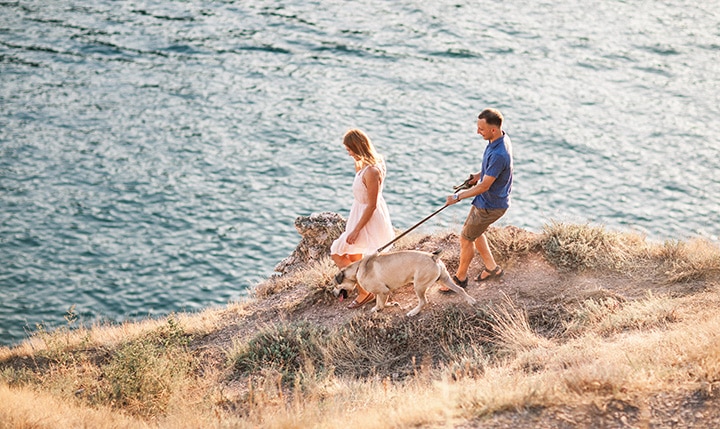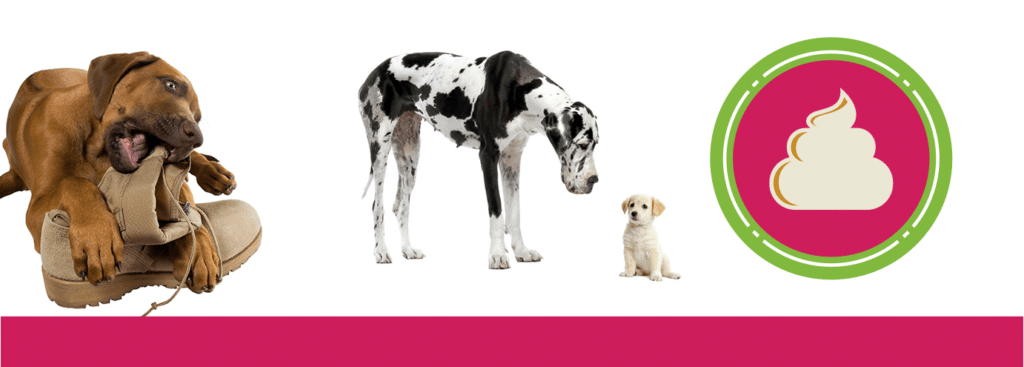How to Exercise Pet Safety While Walking the Dog in the Heat of Summer
Walking the dog is one of the best ways for our four-legged companions to get exercise and explore the world. Dogs both love and need to be walked. Walking provides great exercise and allows dogs to partake in their favorite ancestral habit—peeing on everything. With the heat indexes rising, it\’s important to know when it\’s too hot to walk your dog. Also important is knowing the best ways to keep them from experiencing heat stroke (hyperthermia).
According to a British Veterinary Association study, 48% of vet clinics had to treat dogs for heat stroke during the summer months. The two prevailing reasons heat stroke occurs is because owners neglectfully leave their dogs in cars and dogs overheat due to vigorous exercise while on a walk. Many pet parents aren\’t even aware that their dog is severely overheating. Even when the air temperature is only 86-degrees F, the asphalt temperature can swelter to 135-degrees F—hot enough to fry an egg in five minutes. Imagine this on your dog\’s paw pads!
Dogs also have a different way of cooling down than humans. Humans regulate heat by sweating. The primary cooling method for a dog is, of course, panting. The way it works is a dog\’s tongue swells up—fills with warm blood—while air is forced rapidly over the tongue. As a dog pants, their breathing matches the natural resonant frequency of the airways. This allows warm moisture to evaporate from the tongue which is exhaled while cooled blood returns from the tongue into the body. Dogs have small sweat glands on their feet but these sweat glands are not enough to be a thorough heat losing mechanism.
Heat Strokes (Hyperthermia) in Dogs
The veterinary definition of hyperthermia is when a dog\’s body temperature is elevated beyond an accepted normal range. The temperature typically associated with hyperthermia is 106-degrees F. At this temperature, inflammation of the body occurs with a possibility of brain damage and even fatality. This makes it very important to be observant while walking the dog in hot temperatures.
Symptoms of Hyperthermia:
- Red Gums
- Non-Production of Urine
- Sudden Kidney Failure
- Shock
- Heart & Lung Failure
- Vomiting Blood
- Blood in Stool
- Seizures
- Lethargy
- Muscle Tremors
- Uncoordinated Movement
- Unconsciousness
The two most common factors behind dogs overheating are easily preventable. Being aware of the environmental temperature and your dog\’s body language can help prevent them from getting hypothermia. When walking the dog in the heat, the increased muscle activity generates an exorbitant amount of body heat. The rise in environmental heat puts dogs at risk during long walks, without shade or access to water. As you walk the dog, continually monitor their behavior and make sure you take breaks if they are excessively panting. Providing water for them to drink at these breaks is also important.
Leaving a dog in the cark is another easily prevented situation that leads to dogs overheating. Even on a fair day, it only takes minutes for a parked car to turn a car into a brick oven. Even with the windows cracked it is not safe. On a 78-degree day, the inside of a parked car will swelter to 100 degrees in a few minutes. If you need to run errands and cannot bring your dog, please leave them at home in the air conditioning, instead of in a parked car.
Dogs that are Susceptible to Overheating:
- Young puppies & senior dogs have a harder time regulating their internal body temperature
- Obese dogs have extra layers of insulation in the form of fat which prevents them from cooling
- Brachycephalic dogs (squishy faced breeds) have a more restricted breathing pathway which hinders them from cooling down
- Dogs diagnosed with laryngeal paralysis (narrow breathing passage) also have a more difficult time breathing and consequently harder time dissipating heat
- Dogs with dark coats who absorb more solar radiation instead of reflecting it
How to Avoid Heat Stroke While Walking the Dog
Timing of the Walk
A little bit of common sense goes a long way for your dog\’s safety. The middle of the day, when the sun is highest in the sky, is, of course, going to be the hottest time of day. Try and take your dog for a walk either early in the morning, or late at night, when the temperature isn\’t quite as scorching. If you have a dog-walker take your dog out while you are at work, ensure they are walking your dog at an appropriate time.
Route of the Walk
Try and pick a route that avoids asphalt and concrete. Find a route that is shady. This will avoid any unnecessary heat that your dog experiences. Also, make sure they have access to plenty of water. Bring a collapsible water bowl and water bottle for frequent breaks where your dog can re-hydrate.
Dog Boots & Socks
A pair of dog shoes can help protect a dog\’s paw pads from the heat radiating from the ground. They also protect a dog\’s paws during any season from elements like rocks, broken glass, burrs, snow salt, and other debris which can be dangerous.
Go for a Swim
Dogs need plenty of exercise, even in the summer, but hot temperatures make pet owners consider other ways for dogs to get some exercise. Instead of walking, or going to the dog park, why not visit the dog beach? Swimming is a great form of exercise and helps cool a dog off.
Moisturized Dog Paw Pads
A dog\’s paw pads are naturally tough but were never meant to walk over the hot asphalt and concrete. Paw pads can become cracked, irritated, and collect debris from the ground that can damage the paw pad. If your dog is vulnerable to damaged paw pads you can apply coconut oil to their paws to help alleviate any irritation. Splash and Dash Groomerie & Boutique also offers a \’pawdicure\’ service that moisturizes your pup\’s paw pads—preventing cracking, peeling, and cleansing away bacteria with an effervescent scrub.
Trimming the Nails and Hair Between the Toes
Having your veterinarian or groomer trim the hair between a dog\’s toes helps them gain traction. It also prevents dirt, twigs, and other debris on the ground from getting lodged into their paws. Maintaining a dog\’s paw-fur also helps with a dog\’s natural temperature regulation.
Trimming a dog\’s nails might not help with keeping them cool but it is equally important for their health.
Splash and Dash Groomerie & Boutique wish you luck while walking the dog this summer. Please be safe and make sure your dog has plenty of water and shade. In the worst case scenario, if your dog does experience heat stroke, know how to cool your dog down.
For tips on bringing your dog\’s body temperature down, click here.
Follow Splash and Dash Groomerie & Boutique:
- Website: http://splashanddashfordogs.com/
- Website: https://splashanddashfranchise.com/
- Facebook: https://www.facebook.com/splashanddashfordogs/
- Instagram: @splashanddashfordogs
- LinkedIn: https://www.linkedin.com/in/dan-j-barton-622ab517
- Twitter: splashanddash4dog



